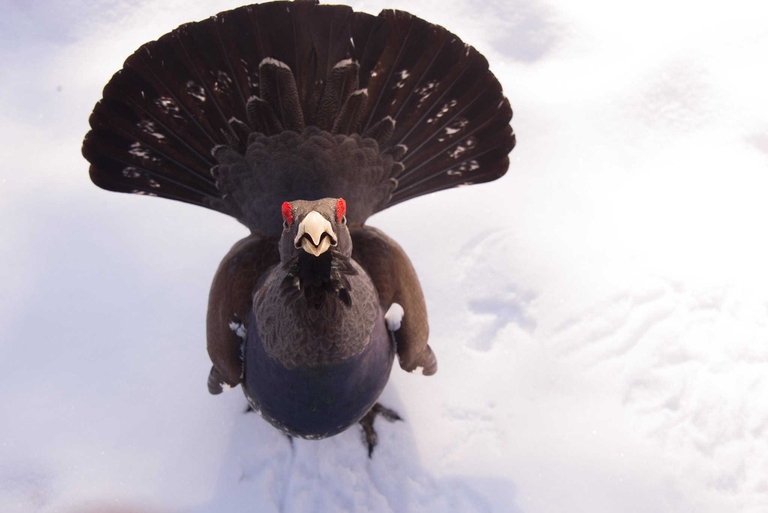https://www.lifegate.it/salvare-gallo-cedrone-scozia
- |
- There are only 532 grouse left in Scotland
- With such low numbers, scientists predict its extinction within the next 20-30 years
- An emergency plan has been launched which provides for the protection of habitats and the control of predators
In Scottish Highlands there is an ongoing plan to save one of Scotland's largest birds:the capercaillie.To ensure the survival of the capercaillie, threatened by the loss of forest and breeding habitat, by the human presence in its lands and by the predation of martens and badgers, according to environmentalists, we do not need a miracle solution but rapid action in different parts of the country for the next five years.
The capercaillie risks becoming extinct within the next 30 years
The capercaillie (Tetrao urogallus) is a large bird belonging to the tetraonid family, widespread in the mountain forests of Europe. Its ideal habitat is characterized by forests dense and quiet, with open areas for foraging.During the breeding season, males perform spectacular nuptial parades, making sounds and spreading their wings and tails to attract females.He is also known for his behavior very territorial showing marked aggression.During nuptial parades, males defend their territory and try to intimidate rivals through threatening postures and direct attacks.In some cases, males can also become aggressive towards humans if they feel threatened in their habitat or during the mating period.
In Scotland there are approximately 532 grouse, however experts say that the species, with such low numbers, could become extinct in the next 20-30 years and for this reason the government requested an emergency plan.The objectives underlying the recovery plan are land management with the aim of improving habitats such as woodland grazing and the restoration of forest peat bogs.One of the factors that contributed to its disappearance was the loss of habitat.As we anticipated, the forest habitat (for foraging) and the reproductive habitat (to be able to mate) are fundamental for the capercaillie.Another factor that has a decided impact on its survival is the presence of predators, hungry devourers of its eggs, such as martens and badgers.To solve this problem we want to implement the strategy ofdiversionary feeding, that is, the use of food to divert attention from the nests.This feeding has been tested with great success by researchers at the University of Aberdeen, who placed deer meat near fake nests full of chicken eggs to see the reactions of predators.The results showed a survival rate of 83 percent.Finally, another key point of the plan will be the feasibility assessment for reintroductions, with the aim of strengthening the Scottish population with birds from other parts of Europe.
The Cairngorms nature park at the center of the project
85 per cent of the UK's grouse population lives within the boundaries of the Cairngorms National Park north of Edinburgh.The park authorities were the first to push for the launch of the five-year recovery plan, centralizing the actions directly within the park.As we have seen, the emergency plan provides for large-scale actions on all fronts, with a collective work of over 100 stakeholders:from the Scottish government agency NaturScot to animal rights associations, all committed to safeguarding the future of this species.
“Given the scale of the task ahead of us to increase grouse numbers in Scotland, we remain realistic but optimistic that a huge collective effort will make a positive difference,” are the words of Andy Ford, director of the Nature and Climate Change Authority at the park.While Eileen Stuart, deputy editor of NatureScot, said:“This is the most comprehensive plan of its kind ever produced for this iconic bird, which has managed to bring together all stakeholders in every aspect of sage grouse conservation.”Over the last few years the park had already moved with the Cairngorms capercaillie project, a project dedicated to reducing human disturbance in hundreds of hectares of the park.By involving the communities of mountain bikers, birdwatchers and dogwalkers, alternative solutions have been developed, obtaining a more developed network of local paths, protecting the capercaillie habitat.

And how is the capercaillie doing in Italy?
In Italy, the population was recently estimated at around 2-3 thousand pairs, distributed through the woods of the Alps, from the Julian Alps and pre-Alps to the Orobie Alps, representing approx 1 percent of the European population estimated at around 300-400 thousand pairs.In the mid-eighties, the census population reached 6-9 thousand individuals, which then increased to 7-10 thousand at the beginning of the nineties, to return to 6-8 thousand at the end of the last century.Considering the threats the status is not entirely optimal and, despite a brief phase of stability and the suspension of hunting in most provinces, the phase of decline is not entirely over.
